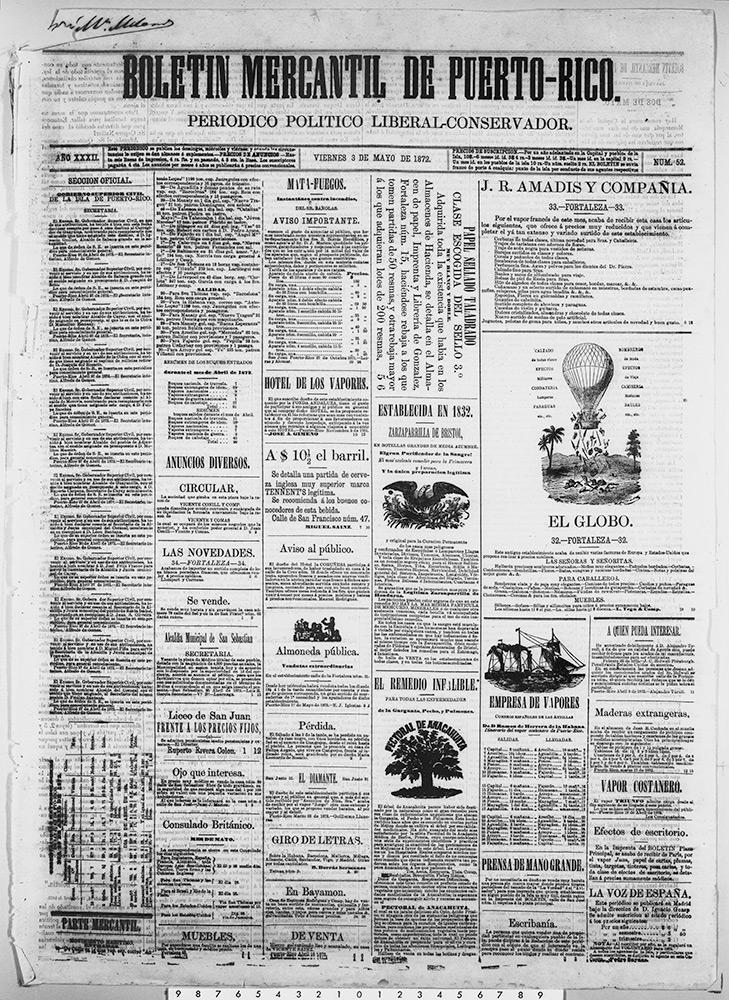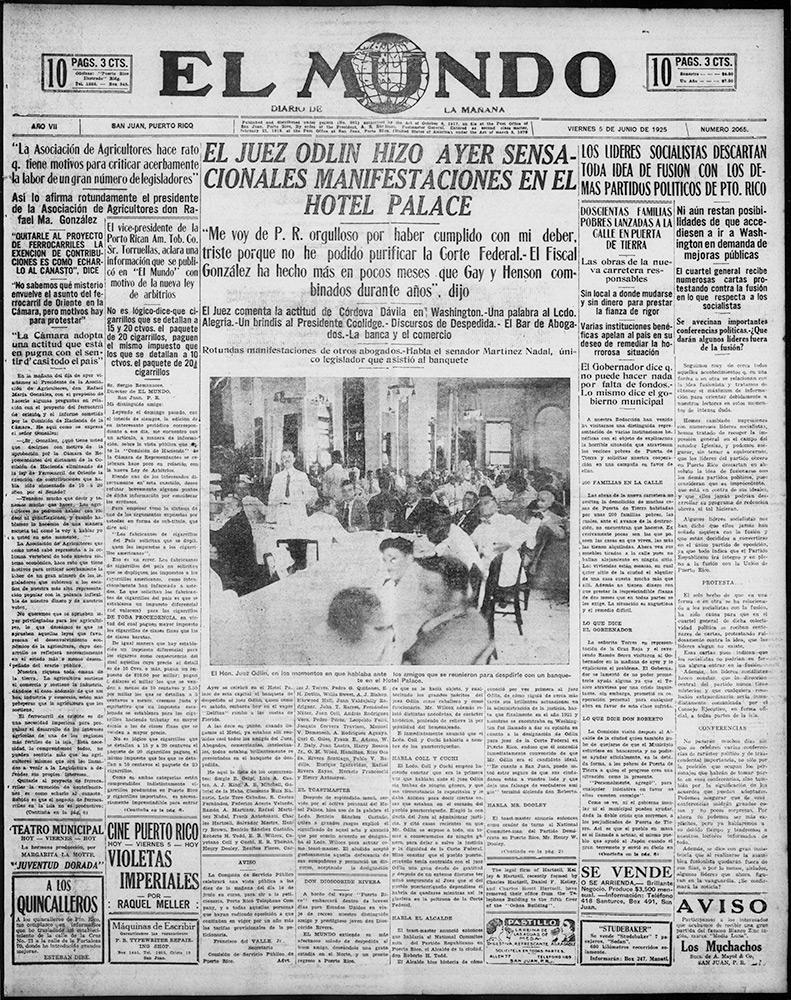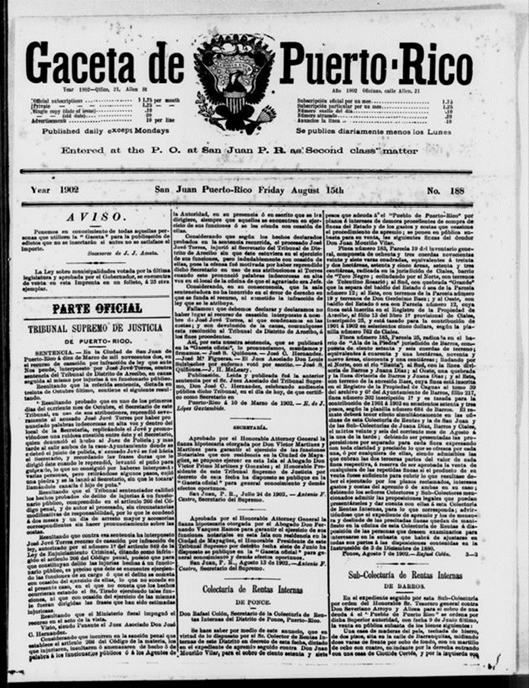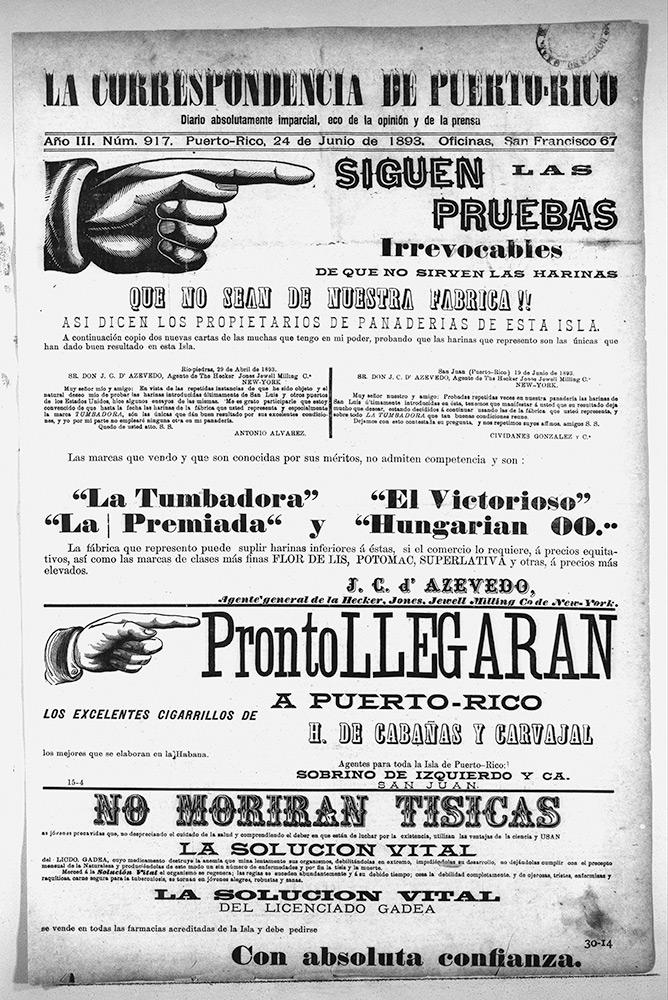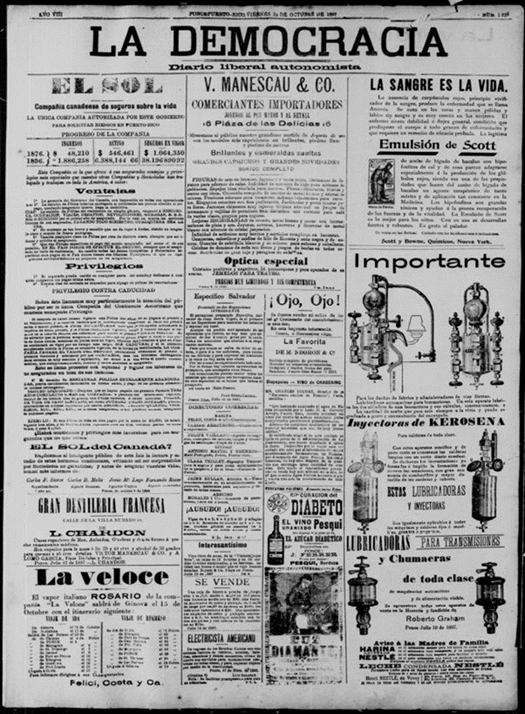Exploring Puerto Rico’s Past: 6 Historical Newspapers and Their Insights
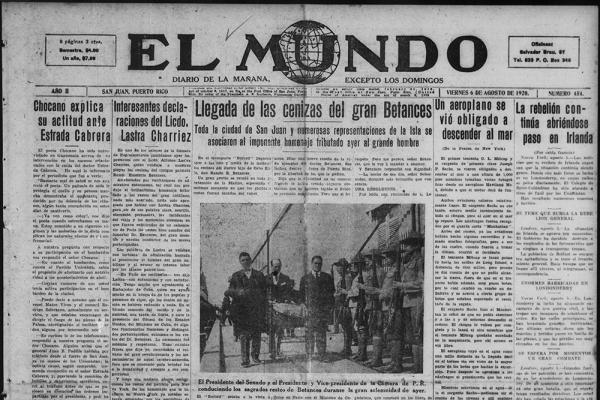
University of Puerto Rico, Río Piedras Campus, Library System

University of Puerto Rico, Río Piedras Campus, Library System
Since the introduction of the printing press to Puerto Rico in the early nineteenth century, the island has witnessed the rise and decline of more than a hundred daily and weekly "periódicos" (newspapers). Most of these publications have emerged from the island's primary urban centers, namely Ponce and San Juan. San Juan, the present-day capital of Puerto Rico situated along the northern coast, and Ponce, the former capital of the southern coastal region during Spanish rule, established by settlers in 1692, have both served as pivotal locations with historical significance. Ponce, particularly, boasts a long-standing Caribbean port that has functioned as a crucial transportation nexus for the local agricultural and sugarcane industries in the region. This prominence as a commercial hub also translated into a significant role as a publishing center. Although we currently have access to only six titles within the Chronicling America database—five originating from San Juan and one from Ponce—it's important to note that a plethora of other newspapers were indeed published concurrently, not only in these cities but also in places like Mayagüez.
Throughout the nineteenth century, newspapers in Puerto Rico encompassed a wide array of topics, spanning from contemporary happenings, cultural aspects, and daily life under the rule of Spanish colonial powers, to the struggles for independence unfolding across other Spanish colonies in the Americas and abroad. After the year 1898, the newspapers extensively covered Puerto Rico's transition into a U.S. territory and the culmination of Spain's governance over the region. The purpose of this blog post is to introduce the six newspapers currently digitized and preserved within the digital repository of historical American newspapers known as Chronicling America. The objective is to underscore the diverse reporting styles and the breadth of coverage encompassing current affairs, political matters, and economic concerns. A number of these periodicals offer researchers a rich wellspring of data beneficial to the humanities. This data includes genealogical sketches; census information; parish and diocese records; lists of migrants; military documentation; pivotal life events such as births, baptisms, confirmations, marriages, and burials; historical maps and photographs; intriguing insights into social norms and traditions; along with an array of advertisements.
Throughout the twentieth century, Puerto Rican newspaper coverage underwent a marked shift toward a more global perspective. This evolution involved a concentrated focus on matters encompassing U.S.-Puerto Rico relations, sociopolitical occurrences, and economic developments. After 1898, following the ratification of the Treaty of Paris and the culmination of the Spanish-American War, newspapers centered their reporting on pivotal milestones such as Puerto Rico's transformation into a U.S. territory and the intricacies of daily life on the island. The historical newspapers from Puerto Rico accessible to us today serve as windows into the viewpoints and experiences of the island's populace during the 1800s and 1900s. They furnish us with firsthand insights into how the inhabitants perceived and engaged with the broader world. Notably, these newspapers provide a distinct vantage point on global events within the Caribbean and the Americas during these centuries, extending their gazes even further afield.
Chronicling America is a project of the Library of Congress and the National Endowment for the Humanities. A pillar of NEH, the National Digital Newspaper Program, began in 2003 to support cultural heritage institutions in every state and territory, including libraries, historical societies, and universities, to select, digitize, and deliver content from their newspaper collections to the Library of Congress. Within this post, I invite you to embark on an exploration of the abundant historical knowledge encapsulated within this collection of six papers, totaling more than 33,000 digitized issues. Among these publications, the Boletín Mercantil de Puerto Rico emerges as exemplary for its comprehensiveness and expansive coverage; Chronicling America provides an astounding 34 out of 37 years in print. Immerse yourself in the extensive offerings of La Gaceta de Puerto-Rico, a publication that presents an array of 10,643 digitized issues spanning almost six decades from 1836 to 1902. Although Chronicling America doesn’t encompass the initial three decades from its inauguration in 1806, the wealth of knowledge within the available issues is unparalleled. Delve into the transformative socio-political and economic landscape through the lens of La Democracia, which provides documentation of significant changes over 4,244 digitized issues between 1891 and 1907. Additionally, venture into the intimate collections of El Imparcial and El Mundo, each encompassing the first six years of their publication, commencing in 1918 and 1919, respectively. Lastly, dive into La Correspondencia de Puerto Rico, presenting a holistic digest of its first 20 years in print with 6527 editions digitized. These invaluable archives present an unparalleled opportunity to unveil Puerto Rico's historical fabric and foster a deep comprehension of its multifaceted history.
It's important to recognize that these six newspapers merely scratch the surface of Puerto Rico's newsprint landscape during the nineteenth and twentieth centuries. Many others await digitization and remain beyond the immediate reach of researchers. Below is a summary of the type of content that each of these recently digitized historical Puerto Rican newspapers holds, providing a glimpse of what awaits within.
1. Boletín Mercantil de Puerto Rico (San Juan, PR, 1839—1918)
Debuting in 1839, the Boletín Mercantil de Puerto Rico held a significant position throughout Spanish colonial rule. It served as a conduit for Spanish commercial interests while adopting a conservative perspective on daily affairs and political matters. The newspaper's coverage traversed a diverse range of subjects, encompassing mercantile movements, economic production, the global market, and the intricacies of Spain's relations with Puerto Rico. Beyond its dedicated attention to business and politics, the publication wove cultural threads into its fabric, featuring articles spotlighting theater performances and their casts, poems, short stories, and critiques of literary works.
The publication also hosted advertisements promoting various goods and services such as books, school supplies, land sales, accommodations, and restaurants. As Puerto Rico underwent significant historical transformations, particularly during the Spanish-American War and the transition to U.S. control, the Boletín Mercantil de Puerto Rico played a crucial role in reporting on the new economic and political directions of the island, even publishing several issues in English. The paper provided information on critical decisions made by the Executive Council and House of Representatives, as well as reporting on the conflicts occurring in the Philippines and Cuba at the time.
Overall, this newspaper not only chronicled the economic and political landscape of Puerto Rico over several significant periods, but it also captured the cultural and social developments of the time, making it a vital resource for understanding the historical context and transitions that collectively sculpted the Puerto Rico we have today.
2. El Imparcial (San Juan, PR, 1918-1973)
El Imparcial originated in 1918 and, bestowed with the moniker "Diario de la tarde," or the "Afternoon Daily," El Imparcial stood as a prominent informational cornerstone of both twentieth-century Puerto Rican affairs and global events. It often undertook the task of translating and disseminating news originating from international press sources.
The pages of El Imparcial spanned a wide spectrum, encompassing matters that reverberated on both global and local scales. From the cataclysmic happenings of World War I and the Russian Revolution to delving into the United States' stances on worldwide issues, the newspaper held a special place in relaying the dynamics of U.S. political and economic dominance over Puerto Rico. It scrutinized the implications of Prohibition laws and did not shy away from reporting on the wake of natural disasters, including the 1918 San Fermín earthquake—an earthquake of unparalleled severity that struck Puerto Rico. Interestingly, the advertisements within the newspaper seemed to capitalize on the island's distress following the earthquake, using the situation as a promotional angle for product sales.
Moreover, El Imparcial extensively covered efforts to create a Commonwealth of Puerto Rico, going as far as publishing in its entirety the 1922 bill presented to Congress. (The bill, if sanctioned, would have transformed Puerto Rico into a "Free Associate State" of the United States.) While the bill was rejected, it is worth noting that a subsequent bill with altered terms garnered approval three decades later.
3. El Mundo (San Juan, PR, 1919-1990)
Emerging under the mantle of the "Diario de la mañana," or the "Morning Daily,” El Mundo debuted in 1919 and promptly ascended to a prominent position as a vital source of information in Puerto Rico. With a gaze spanning the Americas, Europe, and U.S. news services, it provided a comprehensive mosaic of myriad topics. The newspaper's pages delved into the intricacies of Puerto Rican politics, the ebb and flow of the economy, the tapestry of village life, the reverberations of strikes, the scourge of the influenza epidemic, the quest for women's rights, and the processes of elections. This array of content offered an intricate tapestry that granted readers a panoramic view of local matters.
In addition to its content, El Mundo's advertisement section serves as a window into the influence of U.S. industry, advancement, and corporations upon Puerto Rico. These advertisements showcased U.S.-manufactured agricultural machinery and other technological marvels. It was a testament to how profoundly U.S. industry and modernization had woven themselves into the fabric of Puerto Rican life. Notably, El Mundo maintained consistent coverage of Prohibition-related offenses, chronicling the police's confiscation of rum in Mayagüez—a region pivotal for rum production on the island. This documentation chronicled the far-reaching repercussions of this policy on the local community, offering readers an insight into the social dynamics at play.
4. La Gaceta de Puerto-Rico (San Juan, PR, 1806–1902)
Originated in 1806, La Gaceta de Puerto-Rico stood as a pivotal cornerstone in the annals of Puerto Rico's history. Not only was it one of the earliest newspapers to have graced the island, but it also served as a testament to the dawn of the printing press era in Puerto Rico. This publication had held a vital role as the official newspaper of the Spanish government, furnished an indispensable window into the tapestry of the Spanish colonial rule that had shaped the island's trajectory.
As the herald of that colonial era, La Gaceta de Puerto-Rico assumed the mantle of a custodian of intricate details. It unraveled the colonial government's mechanisms, furnished meticulous accounts of population censuses, illuminated the realm of education, and distributed official documents. In doing so, it provided an invaluable glimpse into the inner workings that underpinned the island during those times. Beyond its administrative accounts, the newspaper also reported on general news, chronicled natural calamities, and captured instances of opposition to the colonial regime—a testament to the essence of dissent and resilience that coursed through the populace.
Over the span of its existence, the paper not only showcased advertisements, announcements, and the pulse of the banking industry but also cast a spotlight on the ever-evolving economic landscape. Remarkably, even in the wake of the transition to U.S. military governance after the Spanish-American War, the publication remained steadfast as a daily beacon (with Mondays being the sole exception) for several years following the end of Spain's dominion over Puerto Rico. It even published a statement from U.S. military governor John Brooke during the transition period and regularly reported on governmental matters in English, demonstrating remarkable adaptability in times of transition.
5. La Correspondencia de Puerto Rico (San Juan, PR, 1890–1943)
Debuting in 1890, La Correspondencia de Puerto Rico swiftly ascended to the pinnacle of daily newspaper circulation on the island. Its resonance among the broader populace earned it the affectionate moniker of "El periódico de las cocineras," or "the housewife's newspaper."
The content disseminated within La Correspondencia de Puerto Rico marked a departure from the conventional partisan press of the era. It charted a course toward relevance that extended beyond the parameters usually explored by its contemporaries.
The pages of this publication were a tapestry of coverage on the impact of the Spanish-American War epoch (1897– 1899). It encompassed the burgeoning democratic formation of the Autonomic Cabinet, the orchestration of representative elections, the tumultuous incursion and occupation by the U.S., and the metamorphosis of the island under U.S. military governance. It spotlighted measures enacted by U.S. governors, including the institution of an 8-hour workday and the advocacy for the substitution of local currency with the U.S. dollar
Aligned with the Union Party of Puerto Rico, La Correspondencia de Puerto Rico lent its voice to the pursuit of self-governance while championing economic and intellectual advancement. Issues often featured poems and literary works, an endeavor that contributed to the propagation of literary modernism in Puerto Rico.
In kinship with its publication counterparts, La Correspondencia de Puerto Rico also narrated the stories of natural upheavals that befell the island. Of note, it particularly shone a light on the 1899 San Ciriaco Hurricane, offering an unparalleled depth of insight into its cataclysmic repercussions upon both the region and its inhabitants in a level of detail that surpassed the scope of contemporaneous publications.
6. La Democracia (Ponce, PR, 1890–1948)
La Democracia was founded in 1890 by Luis Muñoz Rivera, a Puerto Rican poet, journalist, and politician. It was first published in Ponce but later moved its publication to Caguas and finally to San Juan. The newspaper's inception mirrored an alliance with Puerto Rico's liberal Autonomist Party, advocating for expanded rights beneath the Spanish Crown. Its editions magnified the populace's yearnings, chronicling Spain's diplomatic engagements with foreign entities, and shedding light on the Cuban War of Independence in 1895.
As the epoch unfolded, 1899 marked a crucial juncture as the island transitioned into the realm of U.S. military authority. In this transition, Luis Muñoz Rivera visited Washington, D.C., to spearhead the establishment of a civilian administration in Puerto Rico. Even after implementing the Foraker Act and restoring a civilian government, the newspaper persisted in advocating for reform. It lent its resounding voice to socialist demonstrations against taxation, protested the imposition of English proficiency tests for educators, voiced criticism against the Catholic Church, and brought into sharp focus instances of child abuse cases within schools. This constellation of advocacy firmly anchored the newspaper's ethos in the realm of social justice.
La Democracia covered a wide range of issues in subsequent years, including bankruptcies, the phenomenon of emigration to Cuba and Hawaii, tariffs, and the quality of imported flour. These narratives constructed a comprehensive painting of the pressing preoccupations of the time. A look at the advertisements and editorials of the period unveiled a transformative shift in dominance from an assortment of foreign companies before 1898 to the ascendance of U.S. companies in the post-transition era. In 1904, a pivotal juncture materialized as Luis Muñoz Rivera steered the creation of the Union Party. This assembly aimed to foster an alignment between disparate political factions, emboldened to confront the statutes imposed by the U.S. administration.
Conclusion
The historical newspapers of Puerto Rico unveil a trove of insights, a testament to the island's intricate past, which was marked by upheavals in the 1800s and 1900s. In this curated tapestry, we encounter a range of colonial-era periodicals, echoing Spanish commercial interests, to the more progressive publications that focused on the impactful milestones etched during the era of U.S. influence. These newspapers collectively sculpt a vivid and meticulous chronicle of Puerto Rico's journey through momentous transitions and transformative epochs.
Within the pages of these historical Puerto Rican newspapers, one finds a visceral reflection of the island's struggle for autonomy, its intersection with global conflicts, and its persistent quest for self-governance. Amid the narratives carried by articles, interspersed with advertisements and editorials, a panoramic narrative emerges that unveils the oscillations in power dynamics and the gradual evolution of the island's social consciousness.
Nicole Hernandez was an intern in the NEH Division of Preservation and Access during the summer of 2023. She is a PhD student currently pursuing her degree in Sociocultural Anthropology at Arizona State University.
